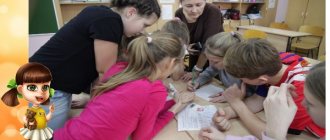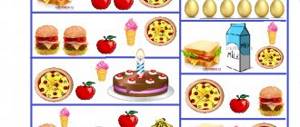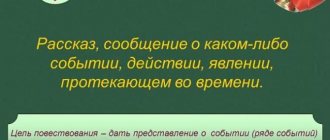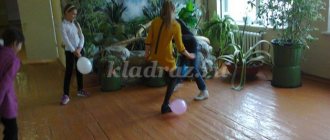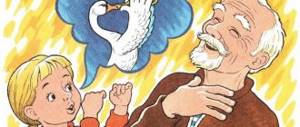Personal pronouns
| I | I |
| You | You you |
| He | He |
Click on a phrase to listen, then click the “Train”
| She | She |
| It | He she it |
| We | We |
| They | They |
Adjust the load yourself: learn from 1 to 6 phrases or words at a time
, you can devote one lesson to simple repetition after the speaker, and the second to cards; it is also useful to “keep a dictionary” (copy words into a notebook)
| I am clever | I'm smart |
| You are clever | You are clever |
| He is clever | He is smart |
| She is clever | She's smart |
| It is big | It's big |
| We are big | We are big |
| They are big | They are big |
Rule No. 1 - don’t overwork, don’t rush, study with interest and regularly (a little every day or every other day)
Rule No. 2 - repeat already learned words and phrases
What form of training is best to use?
In the first stages of language learning, both individual lessons with a tutor and group lessons with other children are suitable. It all depends on the child’s temperament and his individual characteristics.
Classes at school, as you know, do not provide an individual approach to each student and his pace of learning, so if the child’s performance leaves much to be desired, or you are not confident in the school curriculum, then we recommend the English course for children via Skype . On it, your child will be able to learn many new words, learn grammatical structures and finally learn to speak.
Actions
| to walk | walk |
| to draw | paint |
| to grow | grow |
| to wear | wear |
| to count | count |
| to fly | fly |
| to want | want |
| to help | to help |
| to work | work |
| can | I can (can) |
| I can run | I can run |
| can't | I can't (I can't) |
| I can't fly | I can not fly |
| Can you jump? | Can you jump? |
| I have got a pen | I have a pen |
| She has got a pen | She has a pen |
so UNT / English language / Lesson plans in English 2nd grade
Lesson 1. Introductory lesson
01.07.2015 22976 0
Objectives: to familiarize students with the new academic subject “English”; introduction of the words hello, goodbye and names of professions; familiarization with the speech sample What is your path? - My name is... and practicing it in oral speech; development of listening skills; introduction of English sounds [m], [n], [w], [t], [aı].
Equipment: tape recorder; audio recording for lesson 1; audio recording of an English song; a political map of the World; ball; cards with the names of countries and names by number of students.
During the classes
I. Organizational moment
Hi children! I am glad to see you.
(The lesson begins with the teacher greeting. Then he gestures for the students to sit down and at the same time says: “Sit down, please!”)
Just now, children, I greeted you in English and asked you to sit down. We are starting to learn English. I'm your teacher. My name is Maria Petrovna. Let's get acquainted. (Children take turns standing up and identifying themselves.)
II. Introductory conversation
- Let's remember: what country do we live in?
— What language do people speak in our country?
— What language do you speak in your family?
That's right, people in our country speak different languages, but the main language for people living in Russia is Russian. There are many countries where people speak other languages.
— What countries do you know?
— What languages are spoken in these countries?
Now look at the map, I will show you the countries where people speak English.
(There is a political map of the world on the board, and the teacher shows the countries.)
These are America, Great Britain, Australia, Canada and New Zealand. And we are starting to learn English.
— Why do you think we need to learn a foreign language?
It’s absolutely true that if we know a foreign language, we will be able to better get to know the country in which English is spoken, its life, culture, and we will be able to travel around this country. English will help you in your future profession. But to speak English correctly and beautifully, you need to practice a lot. Let's all listen to a song in English together.
(The teacher, at his own discretion, chooses a bright English song to listen to in order to interest the children.)
— Do you want to speak and sing English just as well?
— How about learning to write correctly in English?
It's certainly possible! To do this, you need to study conscientiously in class and at home. You will learn to read and write English letters. You will complete all tasks in the workbook; you must try to do it correctly and accurately. Do your homework in the following order: first work on the oral exercises from the textbook and only then do the written assignments from the workbook. I think you will like the new subject and will have fun studying.
You will quickly remember some English words. Open your textbooks to p. 5, ex. 1. Let's see how the artists greet each other and call themselves.
III. Tongue exercise
When you listened to an English song, you probably noticed that English sounds are different from Russian ones. This is because English pronunciation has its own secrets - the secrets of English sounds. And we begin to get acquainted with these secrets. A little monkey who loves the English language will help us learn to pronounce English sounds. The English call her a monkey.
Now we will do gymnastics for the lips and tongue.
Our monkey loves to make faces. Let's try to play with our lips together.
(The teacher shows the children the movements.)
The monkey smiled slightly (stretch his lips slightly), and now he is serious again (return his lips to a neutral position).
(Children repeat the movement 5-6 times.)
The monkey became upset (clench the lips without protruding, and then return to a neutral position).
The monkey teases (stick out tongue and then hide).
The monkey jumps (press the tip of the tongue first to the lower and then to the upper teeth).
IV. Training students in the perception and pronunciation of sounds [m], [n], [w], [t], [aı]
Our monkey walked a lot, ran through puddles, and her throat hurt. She came to see the doctor. She tries to pronounce her name and pronounces the sound [t]. Let's close our lips and say [m].
The doctor asks the monkey to show him the neck. But it hurts the monkey to open his mouth wide and he says [aı].
We got the English sound [aı], it is a little similar to the Russian ay, but its first part is a long and deep sound.
Then the monkey begins to tease and play around: she stretches out her lips and smiles widely: [w], [w], [w].
The doctor taught the monkey to perform a special exercise for the tongue: to do this, the tongue must be placed on the tubercles above the upper teeth (alveoli) and tapped on them [t], [t], [t].
Well done! Well done!
V. Familiarization with the speech sample What is your name? — My name is... and training in its use
— Guys, if boys and girls come to visit us from Great Britain or America, will you, of course, want to meet them?
— What language do you think you will use to communicate with them?
Of course, in English! Listen to how the doll and the harlequin do it. Now repeat after me: “My name is...”
(Students do exercise 2 (textbook, p. 5). Students repeat after the teacher in chorus and individually the phrases: “What is your name?”, “I am...”)
Now let's learn how to introduce ourselves.
-What do you think you will call your name? That's right, in English! Let's practice calling ourselves.
(Students say their names.)
- Now repeat the sentence and finish it by saying your name: “My name is...”
(The teacher asks each student the question: “What is your name?” and encourages them to answer it. Then the children learn to ask the question, repeating it after the teacher in a whisper and loudly.)
VI. Consolidation of the entered material
Well, now you know how to meet people. Now let's play.
Ball game “Getting to know each other”
Guys, stand in a circle, and I will stand in the center of the circle. I will say my name and throw you the ball. The student I threw the ball to will have to say his name. But don’t forget that we meet in English.
(The teacher plays the game. Then he places cards with the names of countries and names prepared in advance for each student on the desks.)
Now imagine that we are all from different countries and met at an international camp. There are cards on your tables that say what country you are from and what your name is. Read the name of the country in Russian and say your name in English.
VII. Development of listening skills
There are many words in Russian and English that sound similar. Let's try to guess the names of some professions. Look at the pictures from exercise. 4 in the textbook on p. 6 and name the professions of these people in Russian. Now let’s listen to the names of these professions in English, match them with the pictures.
(Children complete the task.)
You easily guessed the names of the professions. Now we will try to find some objects in ex. 5 on p. 6.
(Students listen to the audio recording and look for the indicated objects in the picture.)
VIII. Summing up the lesson
And now it's time for us to say goodbye.
— What new did you learn today?
— In which countries do people speak English?
— How do English and American children get to know each other?
At the beginning of the lesson, I told you that you will study not only at school, but also at home. Today you receive your first homework. Read it in the textbook on p. 6. For the next lesson you need to bring pictures of animals: you can draw them yourself or take ready-made ones, and you also need to complete the task in copybook.
Children, stand up, please.
(The teacher gestures that you need to stand up.)
The lesson is over! Goodbye!
Homework
Workbook: ex. 1 (lesson 1, p. 3); bring pictures of animals.
Description of appearance and objects
| Big | Big |
| Small | Small |
| Slim | Slender, thin |
| Fat | Thick |
| Tall | High |
| Fair | Light (about hair color) |
| Dark | Dark |
| Happy | Happy |
| Sad | Sad |
| Clever | Smart |
| Nice | Nice, dear |
| Beautiful | Beautiful |
| She has got dark hair | She has dark hair |
| He has got blue eyes | He has blue eyes |
My house
| Floor | Floor |
| Hall | Hall |
| Wall | Wall |
| Shelf | Shelf |
| Radio | Radio |
| This is my home | This is my home |
| This is my room | This is my room |
| My room is big | My room is big |
| What's this? | What is this? |
| It's a chair | This is a chair |
| I have got a table | I have a table |
Weather and nature
| Flowers | Flowers | |
| Grass | Grass | |
| Stars | Stars | |
| Tree | Tree | |
| Garden | Garden | |
| Island | Island | |
| Sea | Sea | |
| What's the weather like? | What's the weather like? | |
| It's sunny | Sunny | |
| It's cloudy | Cloudy | |
| It's hot | Hot | |
| It's cold | Cold | |
| It's rainy | It is rainy | |
| I like summer | I like summer |
Animals
| Monkey | Monkey |
| Mouse | Mouse |
| Frog | Frog |
| Kangaroo | Kangaroo |
| Bird | Bird |
| Ant | Ant |
| Bee | Bee |
| My favorite animal is monkey | My favorite animal is monkey |
| This is my cat. It is big and black. | This is my cat. It's big and black. |
How to learn English in 2nd grade on your own?
- Try to surround your child with English at home. If your little one loves to read books, read books in English together every evening. Make it a family tradition.
- Colorful comics are also a great way to learn a language. For very young children, comics about famous characters are suitable, for those who are older, original comics based on English grammar have been invented.
- Listen to your favorite songs in English in the car on the way to school; it will be even better if you and your child sing along with the performer.
- Have an English tea party . Place dolls and teddy bears at the table, explain to the child what a five-o-clock is, tell about the traditions of England, the queen. Offer to converse in English like true royalty.
- When going to the store , ask your child to name in English everything you put in the basket.
- On New Year's Eve, to be on the safe side, suggest writing a letter not only to Santa Claus, but also to his American relative , Santa Claus . In English, of course.
Food
| Cake | Cake, pastry |
| Biscuits | Cookie |
| Chips | Chips |
| Pizza | Pizza |
| Fish | Fish |
| What's your favorite food? | What is your favorite food? |
| My favorite food is fish | My favorite food is fish |
| I like chocolate | I like chocolate |
| I don't like chocolate | I don't like chocolate |
Cloth
| Take off | Take off | |
| Put on | put on | |
| I'm wearing a jacket | I'm wearing a jacket | |
| He's wearing jeans | He wears jeans | |
| She's wearing her red dress | She's wearing a red dress |
What should a second grader know by the end of the year?
By the end of the second year of study, the child should master the following skills:
- Write letters , know their order in the alphabet.
- Write words from the conversation topics covered.
- Compose your own simple sentences using the model or supplement the sentences with the necessary words.
- Read short texts consisting of simple sentences, after listening to them in recordings.
- Understand the main content of simple stories built on familiar words, based on pictures.
- Participate in simple dialogues , be able to say hello and goodbye, answer questions about yourself, and also maintain a simple conversation on everyday topics: “Family”, “School”, “Working day”, “My home”.
Toys
| Bike | Bike |
| Toy | Toy |
| Kite | Kite |
| Boat | Boat |
| Ballerina | Ballerina |
| What have you got? | What do you have? |
| I've got a bike | I have a bicycle |
| I haven't got a bike | I don't have a bike |
| She has got a doll | She has a doll |
| He has not got a bike | He doesn't have a bike |
| Where is the ball? | Where's the ball? |
| It's under the table | It's under the table |
What is the best way to start learning English for a second grader?
If your child has been learning the language since first grade, the start of the new school year will go smoothly. After all, learning begins with the alphabet and rules of reading in English.
But if he is just starting to get acquainted with English, then he will have to master the alphabet and basic reading skills in literally a month. So, before the start of the school year, you should pay attention to the basics of the English language.
The second grade program consists of grammatical and lexical material. We have collected the basic concepts:
Grammar topics
- The verb “to be” and forms of the verb “to be” in the present tense.
- "have got" structure.
- Possessive pronouns, possessive case.
- Cardinal and ordinal numbers. Count to 100.
- Rules for forming the plural of nouns.
- Prepositions of place.
- Rules for using the definite and indefinite articles.
- Modal verb "can".
- Present simple tense.
- Question words, special questions in the present simple tense.
- Demonstrative pronouns “this/these”, “that/those”.
- Special questions in the present continuous tense.
- Present continuous tense.
Basic phrases and expressions in 2nd grade
- Acquaintance
Hello! Goodbye! What's your name? – My name is... How are you? – I'm fine, thank you. How old are you? – I'm seven. I'm a boy/girl. This is my friend.
- Colors
It's yellow / green / blue / red / orange / pink / black / brown / gray / white / purple. My favorite color is (blue). What color is it?
- Family
This is my family. This is my mother / mother / dad / father / brother / sister / grandmother / grandfather. I have got a (mother).
- School
I have got a book / pen / pencil / rubber / ruler / bag / pencil case. This is my (pen). My (pen) is (blue).
- My house
This is my home. This is my room/house. M y (room) is big / small. M y (chair) is (brown). What's this? – It's a house / chair / table / radio / bed / kitchen / bedroom / living-room / bathroom / window / door / floor. I have got a bed / table / chair / TV / shelf. Where is (the chair)? – It's on / in / under / next to (the table).
- Toys
What have you got? — I've got a ball / doll / plane / car. I haven't got drums / a guitar / soldier / ballerina. He / She's got a train / boat / teddy bear. He hasn't got a bike / kite / puppet. This is my (car). It is (red) and (small). Where is the (ball)? – It's under / on / in the (table).
- Skills
I can run / jump / play / climb / swim / eat / drink / dance / sing. I can't fly. Can you jump? – Yes, I can. / No, I can't.
- Body parts
I have got eyes / ears / a nose / a mouth / legs / hands / dark hair / blond hair. I have got (brown) eyes and (long) (dark) hair. My nose is small.
- Animals
I have got a cat / dog / parrot / rabbit / mouse / hamster / tortoise. This is a monkey / elephant / crocodile / bird / duck / chimps / frog / horse. My favorite animal is (a cat). This is my (cat). It is (big) and (black). It has got (a nose). It can (run).
- Food
What's your favorite food? – My favorite food is pizza / cake / biscuits / fish / chips. I like apples / bananas / bread / juice / milk / eggs / cheese / chocolate / tea. I don't like ice-cream / chicken / hot dogs.
- Weather and seasons
What's the weather like? – It is sunny / cloudy / rainy / snowy / windy / hot / cold. I like summer / autumn / winter / spring.
- Cloth
I'm wearing a hat / jacket / coat / T-shirt / skirt. He/she is wearing jeans / socks / boots / shorts / shoes.
Learning to count (10-20)
| ten | 10 | |
| eleven | 11 | |
| twelve | 12 | |
| thirteen | 13 | |
| fourteen | 14 | |
| fifteen | 15 | |
| sixteen | 16 | |
| seventeen | 17 | |
| eighteen | 18 | |
| nineteen | 19 | |
| twenty | 20 |
